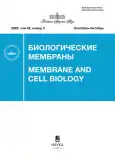Astaxanthin prevents hydrogen peroxide-induced decrease in the viability of AC16 cardiomyocytes
- Авторлар: Lomovsky A.I.1, Baburina Y.L.1, Lomovskaya Y.V.1, Krestinin R.R.1, Sotnikova L.D.1, Krestinina O.V.1
-
Мекемелер:
- Institute of Theoretical and Experimental Biophysics of the Russian Academy of Sciences
- Шығарылым: Том 42, № 5 (2025)
- Беттер: 406-413
- Бөлім: ***
- URL: https://journal-vniispk.ru/0233-4755/article/view/353193
- DOI: https://doi.org/10.31857/S0233475525050056
- ID: 353193
Дәйексөз келтіру
Аннотация
The effect of astaxanthin (5 and 10 μM), a xanthophyll carotenoid, on the viability of human cardiomyocytes AC16 under the cytotoxic action of 100 μM hydrogen peroxide was investigated. It was shown that the combined effect of these substances leads to an increase in the number of living cells and the mitotic activity index. It was found that under hydrogen peroxide-induced cytotoxicity astaxanthin promotes a decrease in the content of protein kinase R-like endoplasmic reticulum kinase (PERK), stimulator of endoplasmic reticulum stress and pro-apoptotic transcription factor C/BEP homologous protein (CHOP). Besides, in the conditions of hydrogen peroxide-induced cytotoxicity astaxanthin restored the expression of anti- and pro-apoptotic proteins of the Bcl-2 family. A protective effect of astaxanthin was revealed despite the toxic effect of hydrogen peroxide.
Негізгі сөздер
Авторлар туралы
A. Lomovsky
Institute of Theoretical and Experimental Biophysics of the Russian Academy of Sciences
Email: ovkres@mail.com
Pushchino, 142290 Russia
Yu. Baburina
Institute of Theoretical and Experimental Biophysics of the Russian Academy of Sciences
Email: ovkres@mail.com
Pushchino, 142290 Russia
Ya. Lomovskaya
Institute of Theoretical and Experimental Biophysics of the Russian Academy of Sciences
Email: ovkres@mail.com
Pushchino, 142290 Russia
R. Krestinin
Institute of Theoretical and Experimental Biophysics of the Russian Academy of Sciences
Email: ovkres@mail.com
Pushchino, 142290 Russia
L. Sotnikova
Institute of Theoretical and Experimental Biophysics of the Russian Academy of Sciences
Хат алмасуға жауапты Автор.
Email: ovkres@mail.com
Pushchino, 142290 Russia
O. Krestinina
Institute of Theoretical and Experimental Biophysics of the Russian Academy of Sciences
Email: ovkres@mail.com
Pushchino, 142290 Russia
Әдебиет тізімі
- Di Cesare M., Perel P., Taylor S., Kabudula C., Bixby H., Gaziano T.A., McGhie D.V., Mwangi J., Pervan B., Narula J., Pineiro D., Pinto F.J. 2024. The heart of the world. Glob Heart. 19, 11. https://doi.org/10.5334/gh.1288
- Fassett R.G., Coombes J.S. 2012. Astaxanthin in cardiovascular health and disease. Molecules. 17, 2030–2048. https://doi.org/10.3390/molecules17022030
- Villaro S., Ciardi M., Morillas-Espana A., Sanchez-Zurano A., Acien-Fernandez G., Lafarga T. 2021. Microalgae derived astaxanthin: Research and consumer trends and industrial use as food. Foods. 10, 2303. https://doi.org/10.3390/foods10102303
- Jackson H., Braun C.L., Ernst H. 2008. The chemistry of novel xanthophyll carotenoids. Am. J. Cardiol. 101, 50D–57D. https://doi.org/10.1016/j.amjcard.2008.02.008
- Beutner S., Bloedorn B., Frixel S., Hernández Blanco I., Hoffmann T., Martin H.-D., Mayer B., Noack P., Ruck C., Schmidt M., Schülke I., Sell S., Ernst H., Haremza S., Seybold G., Sies H., Stahl W., Walsh R. 2001. Quantitative assessment of antioxidant properties of natural colorants and phytochemicals: carotenoids, flavonoids, phenols and indigoids. The role of β-carotene in antioxidant functions. J. Sci. Food Agric. 81, 559–568. https://doi.org/10.1002/jsfa.849
- Pashkow F.J., Watumull D.G., Campbell C.L. 2008. Astaxanthin: A novel potential treatment for oxidative stress and inflammation in cardiovascular disease. Am. J. Cardiol. 101, 58D–68D. https://doi.org/10.1016/j.amjcard.2008.02.010
- Baburina Y., Krestinin R., Odinokova I., Sotnikova L., Kruglov A., Krestinina O. 2019. Astaxanthin inhibits mitochondrial permeability transition pore opening in rat heart mitochondria. Antioxidants (Basel). 8, 576. https://doi.org/10.3390/antiox8120576
- Krestinin R., Baburina Y., Odinokova I., Kruglov A., Fadeeva I., Zvyagina A., Sotnikova L., Krestinina O. 2020. Isoproterenol-induced permeability transition pore-related dysfunction of heart mitochondria is attenuated by astaxanthin. Biomedicines. 8, 437. https://doi.org/10.3390/biomedicines8100437
- Krestinina O., Baburina Y., Krestinin R., Odinokova I., Fadeeva I., Sotnikova L. 2020. Astaxanthin prevents mitochondrial impairment induced by isoproterenol in isolated rat heart mitochondria. Antioxidants (Basel). 9, 262. https://doi.org/10.3390/antiox9030262
- Krestinin R., Kobyakova M., Baburina Y., Sotnikova L., Krestinina O. 2024. Astaxanthin protects against H2O2- and Doxorubicin-induced cardiotoxicity in H9c2 rat myocardial cells. Life (Basel). 14, 1409. https://doi.org/10.3390/life14111409
- Krestinin R., Kobyakova M., Y., B., Sotnikova L., Krestinina O. 2024. Astaxanthin reduces H2O2- and Doxorubicin-induced cardiotoxocity in H9c2 cardiomyocite cells. Biochemistry Moscow. 89, 1823–1833. https://doi.org/10.1134/S0006297924100122
- Liu Z., Lv Y., Zhao N., Guan G., Wang J. 2015. Protein kinase R-like ER kinase and its role in endoplasmic reticulum stress-decided cell fate. Cell Death Dis. 6, e1822. https://doi.org/10.1038/cddis.2015.183
- Nishitoh H. 2012. CHOP is a multifunctional transcription factor in the ER stress response. J. Biochem. 151, 217–219. https://doi.org/10.1093/jb/mvr143
- Liu L., Tang L., Luo J. M., Chen S.Y., Yi C.Y., Liu X.M., Hu C.H. 2024. Activation of the PERK-CHOP signaling pathway during endoplasmic reticulum stress contributes to olanzapine-induced dyslipidemia. Acta Pharmacol. Sin. 45, 502–516. https://doi.org/10.1038/s41401-023-01180-w
- Hirsch I., Weiwad M., Prell E., Ferrari D.M. 2014. ERp29 deficiency affects sensitivity to apoptosis via impairment of the ATF6-CHOP pathway of stress response. Apoptosis. 19, 801–815. https://doi.org/10.1007/s10495-013-0961-0
- Roufayel R. 2016. Regulation of stressed-induced cell death by the Bcl-2 family of apoptotic proteins. Mol. Membr. Biol. 33, 89–99. https://doi.org/10.1080/09687688.2017.1400600
- Chipuk J.E., Moldoveanu T., Llambi F., Parsons M.J., Green D.R. 2010. The BCL-2 family reunion. Mol. Cell. 37, 299–310. https://doi.org/10.1016/j.molcel.2010.01.025
- Litzkas P., Jha K.K., Ozer H.L. 1984. Efficient transfer of cloned DNA into human diploid cells: protoplast fusion in suspension. Mol. Cell. Biol. 4, 2549–2552. https://doi.org/10.1128/mcb.4.11.2549-2552.1984
- Davidson M.M., Nesti C., Palenzuela L., Walker W.F., Hernandez E., Protas L., Hirano M., Isaac N.D. 2005. Novel cell lines derived from adult human ventricular cardiomyocytes. J. Mol. Cell Cardiol. 39, 133–147. https://doi.org/10.1016/j.yjmcc.2005.03.003
- Kruger N.J. 1994. The Bradford method for protein quantitation. Methods Mol. Biol. 32, 9–15. https://doi.org/10.1385/0-89603-268-X:9
- Lavogina D., Lust H., Tahk M.J., Laasfeld T., Vellama H., Nasirova N., Vardja M., Eskla K.L., Salumets A., Rinken A., Jaal J. 2022. Revisiting the Resazurin-based sensing of cellular viability: Widening the application horizon. Biosensors (Basel). 12, 196. https://doi.org/10.3390/bios12040196
- Means R.E., Katz S.G. 2022. Balancing life and death: BCL-2 family members at diverse ER-mitochondrial contact sites. FEBS J. 289, 7075–7112. https://doi.org/10.1111/febs.16241
Қосымша файлдар









